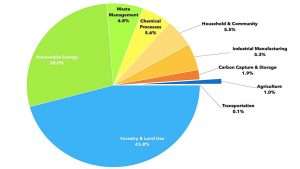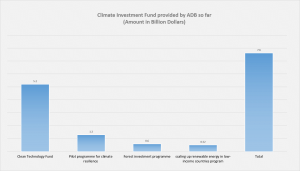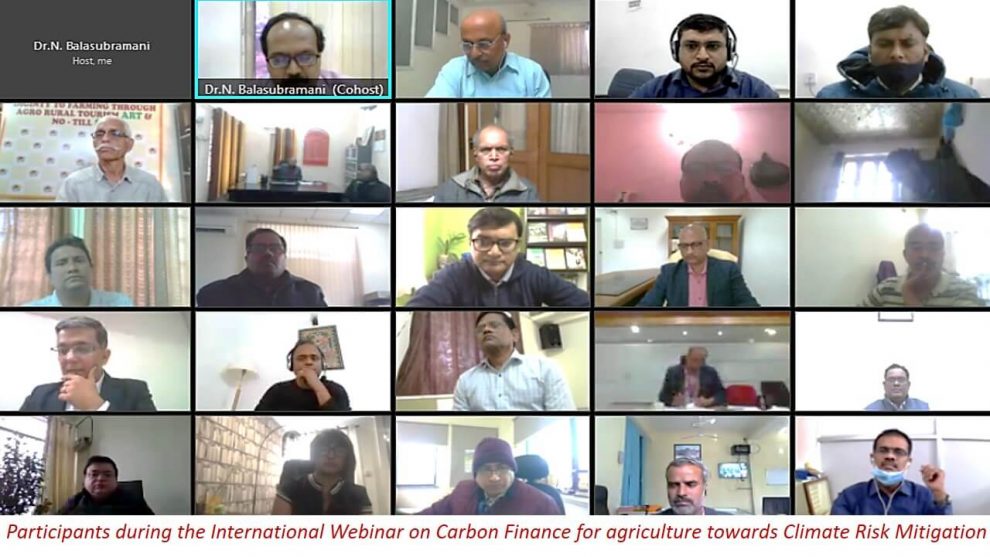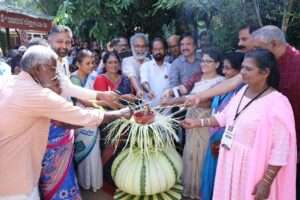The National Institute of Agricultural Extension Management (MANAGE) recently organized a webinar on ‘Carbon Finance for Agriculture towards Climate Risk Mitigation’. In this Meeting Note, Vincent A, N. Balasubramani and Sada Laxmi who organized this webinar, share their observations.
CONTEXT
Green House Gas (GHG) emission has become an important point in agendas, both globally and nationally, as it leads to a rise in temperature, frequent occurrence of drought, reduction in groundwater table, increased forest fires, cyclones, floods, etc. India’s share of the total global GHG emissions is 6.55%, wherein 20% of the emissions are from the agricultural sector. To offset this, constant efforts are being undertaken by both public and private sectors. India has committed to reducing GHG emissions by ratifying the Paris Agreement on 2 October 2016. Its Intended National Determined Contribution (INDC) for the period 2021-2030, is to reduce the emissions intensity of GDP to the tune of 33-35% below 2005 levels, and also to create an additional (cumulative) carbon sink of 2.5-3 billion tonnes of carbon dioxide (CO2), through additional forest and tree cover by 2030. Notably, in the recent COP26 Summit held at Glasgow, 2021, India has pledged to adopt a net-zero emission target by 2070.
Though agriculture is a major contributor to GHG emissions, the GHG mitigation potential of agriculture is estimated to be 5.5-6.0 Gt CO2-eq/year through the adoption of good agronomic, soil and water management practices, agroforestry, etc. Also, there is a growing demand from various countries to fulfil the commitment through voluntary compliances from corporates to offset GHG emissions. Therefore, to sensitize the various stakeholders involved in carbon sequestration, carbon finance and carbon trading, an International Webinar on ‘Carbon Finance for Agriculture towards Climate Risk Mitigation’ was organized on 20 January 2022.
The Webinar was organized and moderated by N. Balasubramani, Director, Centre for Climate Change and Adaptation (CCA) & Centre for Sustainable Agriculture (CSA), MANAGE. It was inaugurated by P. Chandra Shekara, Director General, MANAGE. A total of 858 delegates, including 51 international delegates, such as extension functionaries from agriculture and allied departments, scientists from ICAR institutes/KVKs, officials from corporates, representatives from NGOs, entrepreneurs, freelancers, and so on attended the Webinar.
Eight highly experienced panelists from national and international organizations representing academic and research organizations from both public and private sectors, shared their experiences and expertise.
CURRENT STATUS OF CARBON MARKET AND FINANCE MECHANISMS
The following three Panelists: (i) Mack Ramachandran, Co-Founder, and Director from Futures Inc, Japan; (ii) Venkatachalam Anbumozhi, Director of Research Strategy and Innovation, Economic Research Institute for ASEAN and East Asia (ERIA), Indonesia; and (iii) C.S.R. Murthy, Chief General Manager, NABARD, Mumbai, India, expressed their views on carbon market and finance mechanisms.
 Percentage share of carbon credits issued by area of scope of projects.
Percentage share of carbon credits issued by area of scope of projects.
Source: Berkeley Carbon Trading Project
According to Trove Research, the value of the voluntary carbon market was estimated at 1 billion dollars in 2021 and is expected to grow by 10-50 billion dollars in 2030 with a higher carbon price. The growing carbon market credit can be attributed to increasing net zero commitment agreed upon by signatory countries of COP. It is expected that there will be a shift of demand drivers from compliance purpose to voluntary commitments by 2030 towards achieving net-zero commitments.
However, there is a supply shortage, especially for high-quality credits, on a yearly basis. The gap between supply and demand growth rates is mainly due to: (i) uncertainty of future market development; and (ii) purchasers’ preference for new credits over old credits, given quality issues.

More importantly, sustainable agriculture credits attracted the highest prices in the market. However, agriculture accounts for only 1% of all carbon credits transacted, according to the Berkeley Carbon Trading Project. Conversely, forestry and other land use patterns have generated about 45.8% of all transacted carbon credits. Most of the countries are evolving carbon market mechanism. India can study and adopt a carbon market mechanism suited to the Indian situation so as to utilize the highest carbon price potential scenario. However, there is a need for an enabling policy framework that can motivate a larger number of farmers, i.e., a minimum of one million farmers to adopt globally accepted sustainable agriculture practices, such as Zero Tillage, Organic Farming, Conservation Agriculture (CA), etc.
Large scale adoption can be achieved by aligning the sustainable agriculture projects and programmes of the country to the international agenda on carbon credit practices. India has the power to attract carbon finance as it has in-house expertise in agriculture, a favorable government policy, and robust technologies, including remote sensing/satellite data, etc. In addition, the carbon saving potential is estimated to be two tonnes per farmer. Therefore, leveraging carbon finance will also enhance farmers’ income and reduce climate change risks. However, there is a need to develop a methodology and framework to verify and validate the carbon sequestration potential of different sustainable agricultural practices.
Around 2,22,951 hectares in Himachal Pradesh is considered to be the world’s largest Clean Development Mechanism (CDM), and it has improved productivity and raised the living standards of rural households. In Asia, India has gradually moved towards being carbon positive in the last one decade, yet 70.8% of the CDM projects are implemented by China, and only then comes India (18.5%). It is mainly due to the existing knowledge gaps that don’t support mainstreaming climate change adaptation and mitigation into the extension system, along with poor decision making, insufficient funds, etc.
Many international and national funding agencies are supporting adaptation and mitigation projects. For example, ADB has invested around 7.6 billion dollars as Climate Investment Funds which include Clean Technology Fund (5.2 billion dollars), Pilot programme for climate resilience (1.3 billion dollars), Forest investment programme (639 million dollars), and Scaling up renewable energy in low-income countries (524 million dollars). Similarly, in India, NABARD plays a major role in financing climate smart projects through Adaptation Fund (AF) and Green Climate Funds (GCF), to encourage stakeholders. Most of the funds are spent on agriculture, forestry, biodiversity, livelihood improvement, etc.
Table 1. NABARD’s role in promoting sustainable agriculture
| No. | Name of the Initiative | Budget allotted (in INR) | Impact |
| 1. | Tribal Development Fund (2003 to 2004) | Around INR 2378 crores were sanctioned of which 1688 crores have been disbursed. | A total of 835 projects were sanctioned in 29 states covering 0.5 million acres of land. A total of 27 million trees were planted. Around 5.64 lakh families were covered. The carbon sequestration potential of these initiatives were estimated to be 56.8 million tons of CO2 per year. |
| 2. | Umbrella Programme on Natural Resource Management (UPNRM) | Around INR 784 crores
sanctioned, and 577 crores disbursed. |
A total of 334 projects were sanctioned in states, covering around 0.5 million acres of land and 3.32 lakh families. |
| 3. | Watershed Development | An amount of INR 2390 crores has been sanctioned and 1902 crores were released. | A total of 3401 watershed projects covering an area of 23.4 lakh ha. |
| 4. | ProSoil: Soil Protection and Rehabilitation for Food Security (2019-2023) | An amount of INR 82.71 crores was sanctioned for the project. | A total of 1,53,000 hectares of degraded soil rejuvenated under this project in the states of Maharashtra and Madhya Pradesh; and 13,900 households have benefited so far. There is also a marked increase in yield by 28% in rice, and considerable increase in yield of pigeon pea and wheat crops. |
Most of the funding support has been coming from both international donors and domestic funds, and there is a need for increasing private sector investment. Investment from an international funding agency and public sector, coupled with private sector investment, will help farmers to adopt internationally accepted good agricultural practices on a larger scale.
SUSTAINABLE AGRICULTURAL PRACTICES FOR CARBON SEQUESTRATION
Venkatachalam Anbumozhi, Director of Research Strategy and Innovation, Economic Research Institute for ASEAN and East Asia (ERIA), Indonesia; D.K. Benbi, National Prof., Soil Science, PAU-Ludhiana; Sudarshan Dutta, Lead Agronomist (India), Agoro Carbon Alliance; and Manish Anand, Fellow, Resource Efficiency and Governance Division, New Delhi, shared their experiences on sustainable agricultural practices on carbon sequestration.
Certain technologies and practices, such as Integrated Nutrient Management (INM), no-tillage, residue management and mulching, application of balanced fertilizer, use of cover crops, improved crops/varieties, crop rotation, use of legumes, use of organic manure, etc., are proven to improve soil organic carbon and reduce GHG emissions.
During the Webinar, Agoro Carbon Alliance, a Norway-based organization, said that it aims to improve soil carbon by adopting good agronomic practices, scaling them up with certification, and also providing funding support to good models on carbon sequestration. For example, the initiative of Agoro Carbon Alliance on Conservation Agricultural Practices (CAP) in Soybean, for 10 years in the USA, has resulted in reduced tillage with savings of USD 36,610 per year; added cover crops has helped in earning USD 18,150 dollars per year, and the CAPs in Soybean cultivation has further resulted in optimization of nitrogen worth USD 2730 dollar per year. In India, this organization is also developing a strategy and approach to implement some of the carbon sequestration practices, such as nutrient management (nutrient stewardship), water management (irrigation and products), residue management (tillage), new crop management (cover crops, rotation and intercropping). However, they are looking for a potential partner from academia, scientific organizations, private sector or NGOs for promoting the best practices. This shows that there is an enormous opportunity for stakeholders to make use of such opportunities and leverage carbon finance. The collaborative approach of carbon sequestration projects may generate multiple benefits in terms of improved carbon content, reduced GHG emission, enhanced yield and income.
Table 2. A case of efficient Solar PhotoVoltaic (SPV) pump
| No. | Base of differentiation | Use of efficient Solar PhotoVoltaic (SPV) pump with micro-irrigation | Use of energy inefficient pump with flood irrigation |
| 1. | Water requirement in one hectare for cultivation of wheat | 2328 m3 | 4750 m3 |
| 2. | Approximate cost of irrigation for cultivation of wheat | 63.89 dollars (USD) | 132 dollars
|
| 3. | Water requirement in one hectare for cultivation of paddy | 5880 m3 | 12000 m3 |
| 4. | Approximate cost of irrigation for cultivation of paddy | 163.4 dollars | 338.8 dollars |
This case indicates that the adoption of efficient Solar PhotoVoltaic (SPV) pump with micro-irrigation can save water, labour cost of irrigation, etc. The use of solar power coupled with less water use leads to mitigation of CO2 emission.
ROLE OF PRIVATE SECTOR IN PROMOTING CARBON SEQUESTRATION PRACTICES IN INDIA
Vijay Vardhan Vasireddy, General Manager, Operations, ITC – Social Investments has shared ITC’s experiences with carbon sequestration activities and projects.
ITC is implementing several climate smart agricultural projects and promoting carbon sequestration practices, such as Zero Tillage, Direct Seed Rice, Broad Bed Furrow etc., to improve the adaptation capacity of agriculture to climate change risks. Further, it has partnered with the Climate Change And Food Security (CCAFS) programme of the Consultative Group on International Agricultural Research (CGIAR) for promoting Climate Change Resilient Villages (CCRV). ITC undertakes a vulnerability assessment, develops adaptation tool kits, demonstrates practices and technologies to overcome the identified climate change risk through CCRV. Around 2732 villages in 46 districts across 16 states were covered, and ITC aims to cover an additional 3 million acres in 10,000 villages under CCRV by 2030.

In addition to this, many corporates are promoting good agricultural practices under Corporate Social Responsibility (CSR). However, there is a lack of framework and mechanism to measure and assess the carbon sequestration and GHG emission reduction potential and also most of them are not involved in carbon trading to pass on the benefits to farmers.
Therefore, linking their good agricultural practices promoted under CSR with the carbon market mechanism will encourage a larger number of farmers to adopt and attain co-benefits.
Contribution of an entrepreneur towards an innovative carbon sequestration technique
Chandrashekhar Haribhau Bhadsavle, Founder Member & Managing Trustee of Saguna Rural Foundation, Maharashtra, shared his experience in promoting the Saguna Rice Technique (SRT). He is an Innovative Farmer and had evolved an innovative model, i.e., Saguna Rice Technique (SRT), which is a zero-till, Conservation Agriculture (CA) method. He has been practicing SRT for a long period very successfully in his effort to adapt paddy to climate change risks, and to enhance soil organic carbon as well as reduce GHG emissions. Upon seeing the success of this model, the World Bank-funded Project on Climate Resilient Agriculture (PoCRA), is promoting SRT and more than 5000 farmers in Maharashtra have adopted SRT. Such innovative models/approaches have to be identified, documented, and disseminated for large scale adoption.
WAY FORWARD
Agriculture is one of the major contributors of GHG emissions. Promoting sustainable practices and technologies on a larger scale will minimize the emission of GHGs and help in decarbonisation. However, large scale promotion may not be possible without an enabling policy environment, mass-scale awareness and capacity building programmes for stakeholders at different levels, evolving and utilizing an internationally accepted standardized methodology/framework for assessing the carbon sequestration of sustainable agricultural practices. Furthermore, it calls for mobilizing funds from private sectors and donor agencies, aligning the schemes and programmes of sustainable agriculture with carbon finance related projects, and facilitating the adoption of sustainable agriculture practices at scale by a greater number of farmers and linking them to carbon trade. This will help industries to fulfil their compliances and countries to meet their net-zero emission commitment within the specified year.
 Vincent A, Consultant, Centre for Climate Change and Adaptation (CCA), MANAGE (Email: vincentvinil15@gmail.com).
Vincent A, Consultant, Centre for Climate Change and Adaptation (CCA), MANAGE (Email: vincentvinil15@gmail.com).
 Dr. N. Balasubramani, Director, Centre for Climate Change and Adaptation (CCA), MANAGE (Email: balasubramanimanage@gmail.com)
Dr. N. Balasubramani, Director, Centre for Climate Change and Adaptation (CCA), MANAGE (Email: balasubramanimanage@gmail.com)
 Sada Laxmi, Consultant, Centre for Climate Change and Adaptation (CCA), MANAGE (Email: sadarani456@gmail.com)
Sada Laxmi, Consultant, Centre for Climate Change and Adaptation (CCA), MANAGE (Email: sadarani456@gmail.com)





Add Comment